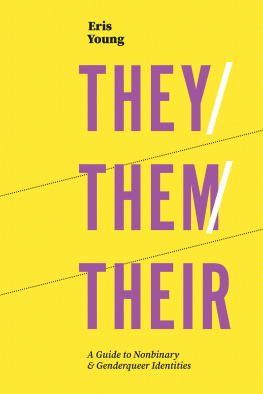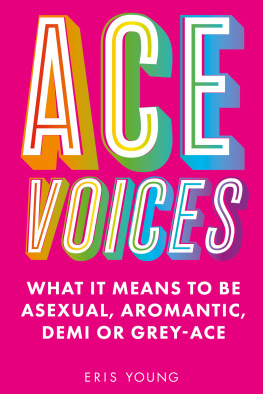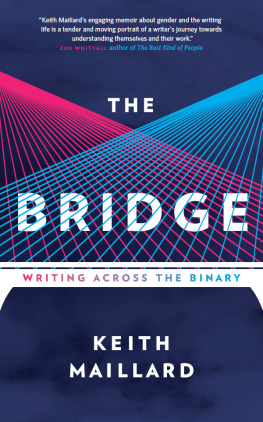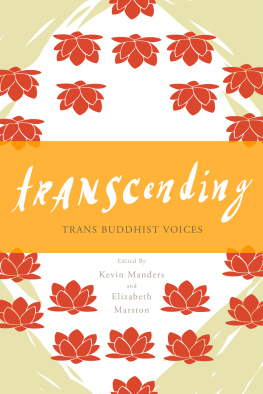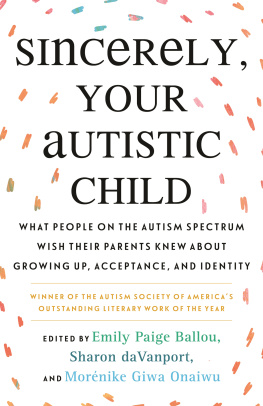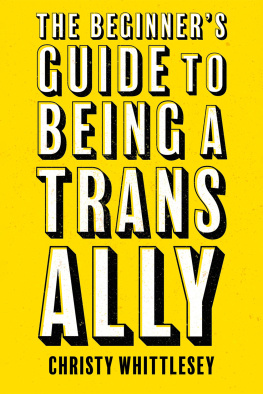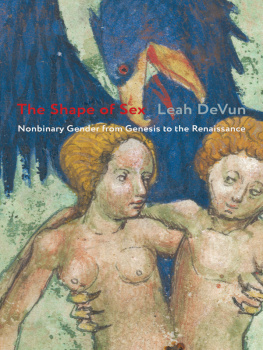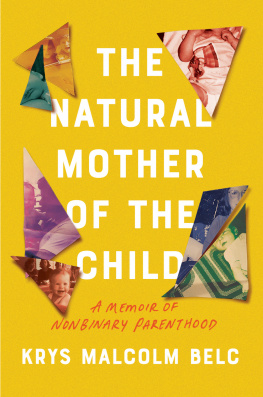
THEY/
THEM/
THEIR
A Guide to Nonbinary and
Genderqueer Identities
Eris Young

Contents
TRIGGER WARNINGS
Dear Reader,
Throughout this book you will find discussions of gender dysphoria and its effects, of non-consensual sex and gender assignment and occasional mention of coercive surgical interventions made against people with non-normative gender or sexual presentations. I make mention several times throughout the book of myths, misconceptions and bad-faith media portrayals of trans, genderqueer and nonbinary people that some readers may find difficult to read about.
Also discussed throughout is violence, a fact of life faced by trans people all over the world. This includes discussion of the statistics surrounding physical assault, murder and sexual violence towards trans people, and in-depth descriptions of institutional and non-physical violence: the non-consensual outing of people as trans, genderqueer or nonbinary, as well as misgendering, the erasure of our identities, systematic inequalities in spheres such as work and housing and gatekeeping of trans peoples access to medical treatment.
Certain chapters and sections may be difficult to read for specific reasons. In , on our experiences in wider society, includes some discussion of family and romantic partner rejection and domestic abuse, as well as of sex and relationships and the potential difficulties therein for genderqueer people.
are devoted to discussions of nonbinary and genderqueer peoples experiences of mental health and medicine, respectively. Both chapters discuss the pathologisation of trans and genderqueer identities, as well as the harm caused by conversion therapy and the historical institutionalisation of individuals with non-normative identities (this is also discussed briefly in the statistics and demographics sections of the first chapter).
also discusses in some depth my own and my interviewees specific experiences with mental illness like depression and anxiety, as well as statistics surrounding suicidality and substance abuse, linked to gender dysphoria and minority stress.
Anecdotes in gives cursory descriptions of some surgical options for trans and nonbinary people.
is devoted to discussion of our experiences with laws and the legal system, and as such includes discussion of experiences with the police, statistics and some specific anecdotes recounting domestic abuse.
I hope that those of you who need it find this warning helpful, and I urge you to skip over or approach in your own time sections or chapters which you might find difficult or traumatic to read.
Thank you for reading on,
Eris
CHAPTER 1
An Introduction
to Nonbinary and
Genderqueer Issues
Introduction
The purpose of this book is to introduce readers to the concepts, contexts and daily struggles of nonbinary-identified and genderqueer people people whose gender identities lie outside the simple binary of male and female. Were a distinct social group existing within the larger transgender and LGBTQ communities, with our own set of vulnerabilities and privileges.
Nonbinary people are becoming more and more visible every day, in movies, TV shows, books (and no longer just science fiction!) and the news, on the runway, even in schools and workplaces. Several celebrities, including Jaden Smith, Amandla Stenberg and Miley Cyrus, have come out as trans or at least gender-nonconforming in some way; activist Maria Munir came out as nonbinary to President Barack Obama during a London town hall meeting in 2016.
Our sudden visibility has come with some backlash: genderqueer people have faced harassment, public ridicule and even violence from people who refuse to accept or try to understand us. But there have also been people willing to listen, to whom our gender identities are not unnatural or impossible but simply another one of the complexities which make us human.
This book is for those people: the people who want to understand but might not yet have the means to do so. Most nonbinary people find the community through the internet. I did, and Ive found the vast majority of my interviewees through the internet as well. The terminology we use to describe ourselves, rooted conceptually in queer theory and the work of Judith Butler and Michel Foucault, crystallised not in the classroom or in community meetings but on websites like LiveJournal and Tumblr. Most of it isnt standardised; self-applied terminology rarely is when it develops organically. Information about us who we are, what the terms mean, how we differ from various other gender and sexual minorities can be found on the internet by anyone with a mind to learn, but it is often contradictory or at least inconsistent. These websites can be hard to find, and while simply googling genderqueer will get you some good sites written by actual genderqueer people, it will also get you a litany of shock-value, hate-mongering misery memoir articles, which are rarely written by the people theyre about.
I dont claim to be master theorist, or even an expert on the subject of nonbinary and genderqueer identities: any authority vested in this book derives from statistics, extensive anecdotal evidence gathered from the community itself and a lifetime of personal experience. I will try to set out as clearly as possible the terminology you need to know to talk about and fully understand our gender identities, and illustrate some of the most common obstacles we face while navigating society at large.
These barriers take many forms; after all, were trying to live our lives outside of, or in opposition to, one of the oldest, most ossified systems in human history: gender. Many domains marriage, fashion, even language are often rendered fully binarised, with no room left over for people who dont fit either label.
In addition, I believe that in todays culture of public shaming and virtue signalling there can be a fear associated with getting it wrong which has perhaps hindered public willingness to learn and explore. I believe that every binary-gendered person should be given the chance to try and understand, and that it is inevitable that they should make mistakes. After all, we grow up in this system, its like water to fish for us. Its a big job to get your head above water and break habits that have been drilled into us since birth; we of the nonbinary community should know this best of all.
On the other hand, being genderqueer can be exhausting. Because most people arent readily equipped to understand our identities, we are constantly having to explain ourselves, our genders and our gender presentations. We get stares, invasive questions and even mockery daily, and this has led quite reasonably to the mentality among many of us that it is not our job to educate people outside our community. This is perfectly true, and it is why I feel privileged to have the energy and ability to explain on behalf of others.
Again, I dont claim to be an authority: I dont doubt I will get some things wrong (and I will happily correct any that are brought to my attention). My definitions are not the only ones; the identity terms I discuss are not the only valid ones. But I do believe that it is my duty to give what I can back to the community, and that begins with this book. As such, in addition to discussing my own experiences as a nonbinary person, Ill be making extensive use throughout this book of surveys and studies conducted by individuals and third-sector organisations like Stonewall and the Scottish Trans Alliance, as well as anecdotal evidence from a number of nonbinary and genderqueer people who have been so kind as to act as interviewees, and share their experiences with me. Throughout this book I will refer to these interviewees by their initials, or by a numbered XX if they prefer to remain fully anonymous. The average age of my interviewees was 26, mode were 24 and 25 (three people each). My oldest interviewee was 45 (next oldest 32) and the youngest 20. I didnt ask my interviewees about ethnicity and race (as the questionnaire I used was meant to be more of a prompt for anecdotal evidence than an exhaustive demographic survey) but roughly speaking the majority of my interviewees were white British, or white American, Latino/a/x American and East or Southeast Asian American.
Next page
